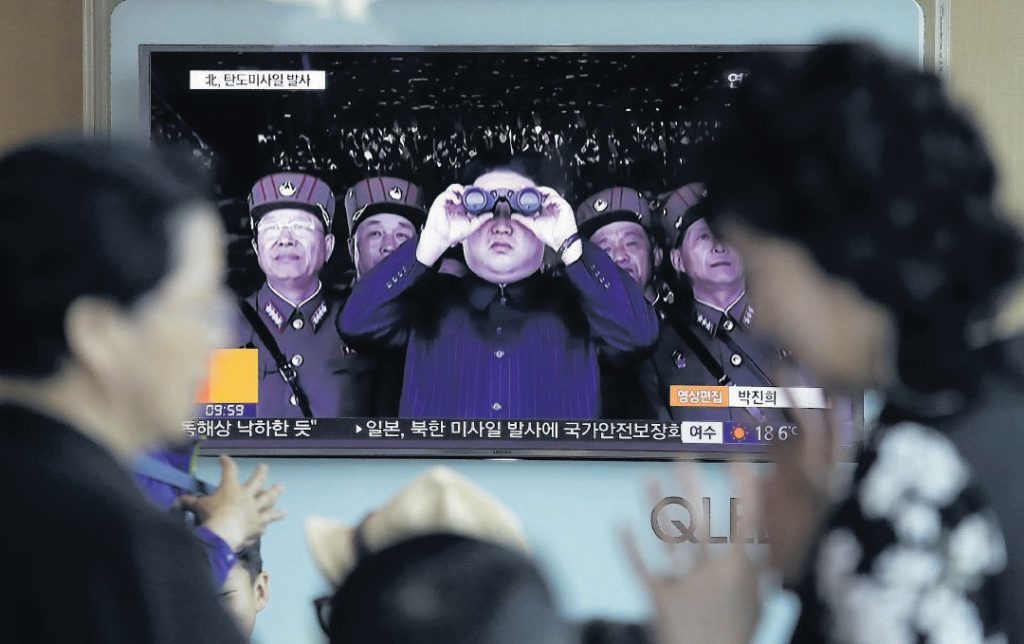
North Korea has fired an apparent ballistic missile that flew almost 300 miles and landed in the waters of Japan’s economic zone.
It was the latest in a string of launches as the North seeks to build nuclear-tipped intercontinental ballistic missile (ICBM) that can reach the US mainland.
The suspected Scud-type missile launched from the coastal town of Wonsan on Monday flew about 280 miles, the South’s Joint Chiefs of Staff said.
It landed in western waters that are Japan’s exclusive maritime economic zone, Japanese chief cabinet secretary Yoshihide Suga said.
He said there was no immediate report of damage to planes or vessels in the area.
North Korea is still thought to be several years away from its goal of being able to target US mainland cities with a nuclear ICBM, but each new test puts it closer to success.
The North has a strong arsenal of short- and medium-range missiles that target Japan and South Korea and US forces in the region, and it is working to perfect its longer-range missiles.
There was no immediate comment from North Korea’s state controlled media.
But the launch followed a report from the North that said leader Kim Jong Un had watched a successful test of a new type of anti-aircraft guided weapon system. It was not clear from the report when the test happened.
After the test, Mr Kim said the weapon system’s ability to detect and track targets had “remarkably” improved and its accuracy also increased, according to the official Korean Central News Agency.
KCNA cited him as ordering officials to mass-produce and deploy the system all over the country so as to “completely spoil the enemy’s wild dream to command the air”.
The North’s nuclear and missile programmes are perhaps the biggest foreign policy challenges to the new leaders in allies Washington and Seoul.
President Donald Trump has alternated in his public statements between bellicosity and flattery. But his administration is still working to solidify a policy to deal with North Korea’s nuclear ambitions.
A new liberal president in Seoul, Moon Jae-in, has signalled he will be flexible in expanding civilian exchange with North Korea.
But many analysts say Mr Moon will probably not push for any major rapprochement projects because North Korea has gone too far on its nuclear programme.
Monday’s missile launch was the third one by North Korea since Mr Moon’s inauguration on May 10.
Mr Moon called a National Security Council meeting to discuss the North’s launch.
Japanese Prime Minister Shinzo Abe, who had just returned from a G7 meeting in Italy, told reporters: “North Korea’s provocation by ignoring repeated warning from the international society is absolutely unacceptable.”
He said Japan will “take concrete steps with the US in order to deter North Korea,” although he did not elaborate on specific actions.
“We will also co-operate with South Korea and other members of the international society and maintain high levels of caution in order to do utmost for the protection of our people’s safety.”
Besides its regular ballistic missile test-launches, the North carried out two nuclear tests last year, in January and September.
Outside analysts believe North Korea may be able to arm some of its shorter-range missiles with nuclear warheads, though the exact state of the North’s secretive weapons program is unknown.
Mr Moon has made tentative steps toward engaging the North by restarting stalled civilian aid and exchange programmes as a way to improve strained ties.
South Korea said recently that it will allow a civic group to contact North Korea about potentially offering help in treating malaria, the first government approval on cross-border civilian exchanges since January 2016.